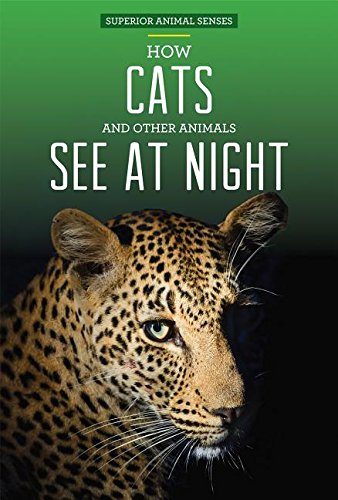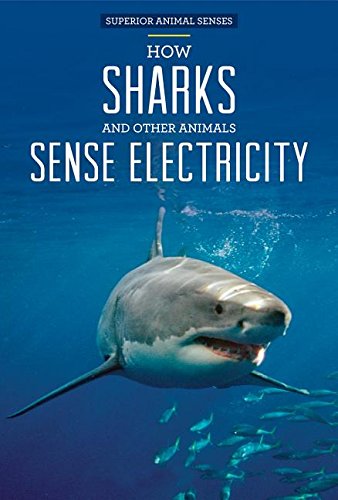-
How Elephants and Other Animals Hear the Earth
Caitlin McAneney, Caitie McAneney
Library Binding (PowerKids Press, Aug. 1, 2015)Elephants are able to sense an earthquake before it happens. How are they able to do this? They can feel the seismic vibrations in the earth through their trunk and their feet. Readers learn how elephants use these vibrations to communicate with each other and sense danger. Fun, memorable facts presented throughout the text address elephants and other animals with similar sensory adaptations, including snakes and spiders. Informative text and a detailed graphic organizer introduce readers to important science curriculum concepts, such as animal adaptations and seismic waves. Vibrant photographs of a variety of animals keep readers engaged as they learn. R
R
-
How Dolphins and Other Animals Use Sonar
Therese Shea
Paperback (Powerkids Pr, Aug. 19, 2015)Describes how such animals as dolphins, bats, oilbirds, and shrews use sound to locate an object and determine its shape, speed, and distance. O
O
-
How Elephants and Other Animals Hear the Earth
Caitlin McAneney, Caitie McAneney
Paperback (PowerKids Press, Aug. 1, 2015)Elephants are able to sense an earthquake before it happens. How are they able to do this? They can feel the seismic vibrations in the earth through their trunk and their feet. Readers learn how elephants use these vibrations to communicate with each other and sense danger. Fun, memorable facts presented throughout the text address elephants and other animals with similar sensory adaptations, including snakes and spiders. Informative text and a detailed graphic organizer introduce readers to important science curriculum concepts, such as animal adaptations and seismic waves. Vibrant photographs of a variety of animals keep readers engaged as they learn. R
R
-
How Cats and Other Animals See at Night
Christine Honders
Paperback (Powerkids Pr, Aug. 19, 2015)Explores how cats and other nocturnal animals see in low light at night. Q
Q
-
How Snakes and Other Animals Taste the Air
Kristen Rajczak
Paperback (Powerkids Pr, Aug. 19, 2015)Snakes are often seen with their tongue sticking out. Theyre not being rude; theyre tasting the air! Snakes use their tongue to sense the world around them. Readers discover this and more as they explore fun facts about snake senses. They also learn about other animals that taste the air, including a variety of lizards. Readers are presented with a helpful graphic organizer as well as bright, detailed photographs of these animals in their natural habitat. The engaging text and colorful photographs present science curriculum topics in a way that will keep readers entertained as theyre learning new things with each turn of the page. O
O
-
How Sharks and Other Animals Sense Electricity
Christine Honders
Paperback (Powerkids Pr, Aug. 19, 2015)Describes how such animals as sharks, sting rays, skates, and sawfish are able to sense electric currents in water in their seach for prey. O
O
-
How Pigeons and Other Animals Sense Magnetic Fields
Ryan Nagelhout
Paperback (Powerkids Pr, Aug. 19, 2015)Explores how pigeons and other animals use the Earth's magnetic field for navigation. R
R
-
How Dolphins and Other Animals Use Sonar
Therese Shea
Library Binding (Powerkids Pr, Aug. 19, 2015)Sonar isnt just used by submarinesmany animals use it, too! Biosonar is a kind of sonar produced and used by animals such as dolphins. Readers discover the biology behind biosonar and are introduced to other animals that also have this amazing adaptation, including bats and shrews. Bright photographs of these animals are presented alongside a variety of fun facts and a helpful graphic organizer. Informative, engaging text touches on essential science curriculum topics, such as animal adaptations, predator-prey relationships, and the science of sound. Q
Q
-
How Cats and Other Animals See at Night
Christine Honders
Library Binding (Powerkids Pr, Aug. 19, 2015)All catsfrom mountain lions to housecatshave amazing night vision. Why do they need it, and what adaptations in their eyes make it possible? Readers find the answers to these questions as they explore the science behind cats superpowered night vision. They also discover other animals that can see well in darkness, such as owls and giant squids. Fun facts about these animals and a detailed graphic organizer touch on a variety of science curriculum topics, and colorful pictures make learning about these topics engaging for readers. Q
Q
-
How Snakes and Other Animals Taste the Air
Kristen Rajczak
Library Binding (PowerKids Press, Aug. 1, 2015)Snakes are often seen with their tongue sticking out. Theyre not being rude; theyre tasting the air! Snakes use their tongue to sense the world around them. Readers discover this and more as they explore fun facts about snake senses. They also learn about other animals that taste the air, including a variety of lizards. Readers are presented with a helpful graphic organizer as well as bright, detailed photographs of these animals in their natural habitat. The engaging text and colorful photographs present science curriculum topics in a way that will keep readers entertained as theyre learning new things with each turn of the page. S
S
-
How Pigeons and Other Animals Sense Magnetic Fields
Ryan Nagelhout
Library Binding (Powerkids Pr, Aug. 19, 2015)How do homing pigeons navigate? They have a special ability to sense magnetic fields. As readers learn about this impressive adaptation, theyre introduced to important science curriculum topics in a fresh, engaging way. Readers explore fun facts about pigeons and other animals that can also detect magnetic fields, including honeybees. Colorful photographs of these animals and a helpful graphic organizer are included to enhance the reading experience. With each turn of the page, readers will gain a new appreciation for pigeons, honeybees, and other animals that have their own built-in compass. R
R
-
How Sharks and Other Animals Sense Electricity
Christine Honders
Library Binding (Powerkids Pr, Aug. 19, 2015)Sharks have a kind of sensory superpower called electroreception. This means they can sense electricity in their watery habitats. Other marine animals, such as dolphins, also share this special sense. Readers discover the ways these animals use their ability to sense electricity and the science that creates this supersense. Fun facts about these animals and their supersense present a fresh look at science curriculum topics such as electricity and animal adaptations. A helpful graphic organizer is also included to aid visual learners. Vibrant photographs of sharks and other animals in their natural habitats add to this electric reading experience! O
O